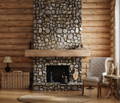The Western Design Style
The Western design style in residential interior design captures the essence and rugged charm of the American Wild West. It evokes images of vast landscapes, cowboy culture, and a connection with nature. This design style celebrates the raw, rustic beauty of the wilderness and the history of the Western frontier. Central to Western interiors are natural materials. Think of hardwood floors, log beams, leather upholstery, and stone fireplaces. The furniture is sturdy, often handcrafted, with a focus on wood and other natural materials. Leather sofas, cowhide rugs, and Native American-inspired textiles lend authenticity to the space.
The color palette is influenced by the natural surroundings of the West while antler chandeliers, horseshoes, Western art, and vintage cowboy gear serve as decor. In essence, the Western design style is not just about aesthetics; it's a tribute to a way of life. It reflects the spirit of freedom, adventure, and reverence for nature that defined the American West.

Western Style Architecture
Deeply rooted in the history and landscapes of the American frontier, the style showcases a synthesis of various influences, including Spanish missions, log cabins, ranch houses, and Native American dwellings. These structures are typically single-story, sprawling, and blend seamlessly with their natural surroundings. Emphasis is on using local materials, such as logs, adobe, stone, and clay tiles. Open floor plans, broad porches, and overhanging eaves are also common.
Western architecture often features single-story, sprawling designs.
Local materials, including logs, adobe, and stone, are predominant.
Broad porches and overhanging eaves provide shade and enhance outdoor connectivity.
Open floor plans facilitate a seamless flow between rooms.
The design often incorporates elements from Spanish missions, ranch houses, and Indigenous dwellings.

Western Style Materials
Predominantly, natural materials native to the American frontier are used. Logs and timber are foundational, often seen in exposed beams, walls, and flooring. Adobe, a traditional sun-dried brick, is another staple, particularly in the southwestern regions. Stone, sourced locally, is used for fireplaces, walls, and foundations while leather and cowhide feature prominently in upholstery and decor. Metals like wrought iron are incorporated in fixtures and hardware, adding a rustic touch.
Logs and timber play a central role in Western structures and interiors.
Adobe, with its earthy tones, is commonly used in Southwestern designs.
Local stones provide a natural, rugged texture to buildings and interiors.
Leather and cowhide bring authenticity, echoing the region's cowboy heritage.
Wrought iron fixtures and hardware add rustic details to the overall design.

Western Style Colors and Finishes
Earthy tones dominate the palette, with shades of brown, beige, terracotta, and muted greens reflecting the desert sands, canyons, and expansive plains. Deep blues might represent the vast skies, while fiery reds and oranges echo the hues of sunsets. As for finishes, they lean toward the rustic. Raw, unpolished surfaces that showcase the material's natural texture and patina are preferred. As such, wood might be distressed or reclaimed while metals are often oxidized or aged.
Earthy tones, encompassing browns and beiges, are foundational in Western color schemes.
Muted greens and deep blues capture the essence of the region's vegetation and skies.
Fiery reds and oranges evoke the vibrant Western sunsets.
Wood finishes in Western designs are often distressed or reclaimed.
Metals feature oxidized or aged finishes, adding to the rustic aesthetic.

Western Style Furniture and Decor
Furniture is typically handcrafted, substantial, and made of solid woods, often showcasing intricate carvings or metalwork. Upholstery leans towards natural materials like leather, canvas, and cowhide. Decorative elements are imbued with symbolism and history. Native American textiles, aged wagon wheels, antler chandeliers, and old spurs serve as decorative accents. Wall art often portrays iconic Western themes, from vast landscapes to portraits of wildlife.
Handcrafted wooden furniture, often with intricate details, is a staple in Western interiors.
Upholstery materials include durable and natural choices like leather and cowhide.
Native American textiles and motifs are frequently incorporated into decor.
Antler chandeliers and aged metal accents evoke a rustic, frontier ambiance.
Wall art and decor pay homage to Western landscapes and wildlife.
Western Style Lighting
Wrought iron chandeliers, often adorned with details like leather straps or wooden beads, cast a warm, ambient glow. Wall sconces made from metals or antlers add character and illuminate nooks and corners. Lantern-style pendant lights, reminiscent of old campsites, hang over kitchen islands or dining areas. Table lamps might incorporate materials like leather, pottery, or wood and often feature shades with Western motifs.
Wrought iron chandeliers, adorned with rustic details, are central to Western lighting.
Antler wall sconces add a touch of the wilderness to interiors.
Lantern-style pendant lights evoke memories of old Western campsites.
Table lamps in Western designs blend materials like leather, pottery, and wood.
Lampshades often showcase Western motifs or scenes, enhancing the theme.